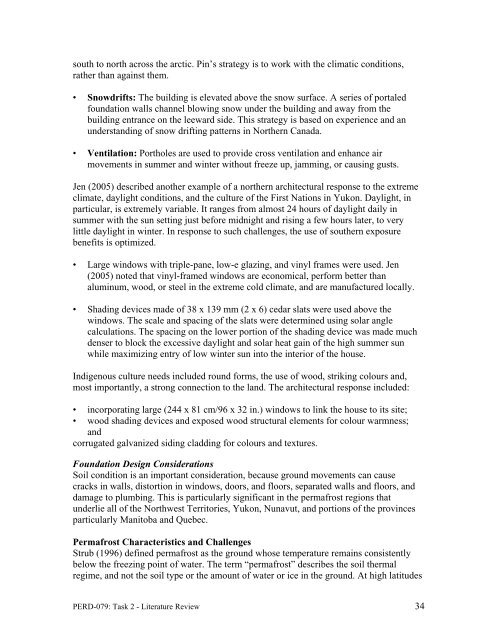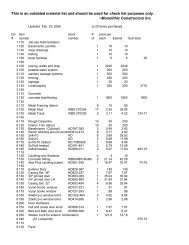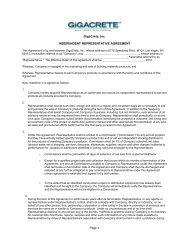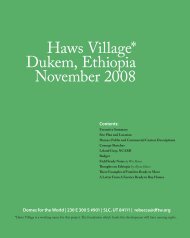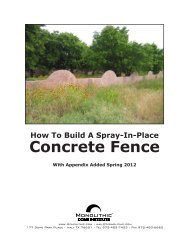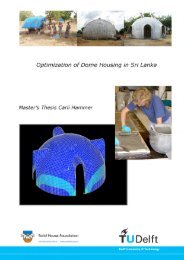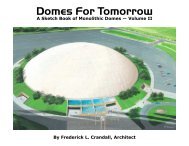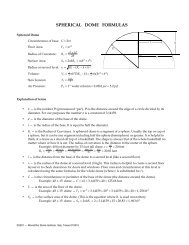Literature Review on Building Envelope, Heating and ... - Beeshive.org
Literature Review on Building Envelope, Heating and ... - Beeshive.org
Literature Review on Building Envelope, Heating and ... - Beeshive.org
Create successful ePaper yourself
Turn your PDF publications into a flip-book with our unique Google optimized e-Paper software.
south to north across the arctic. Pin’s strategy is to work with the climatic c<strong>on</strong>diti<strong>on</strong>s,<br />
rather than against them.<br />
• Snowdrifts: The building is elevated above the snow surface. A series of portaled<br />
foundati<strong>on</strong> walls channel blowing snow under the building <strong>and</strong> away from the<br />
building entrance <strong>on</strong> the leeward side. This strategy is based <strong>on</strong> experience <strong>and</strong> an<br />
underst<strong>and</strong>ing of snow drifting patterns in Northern Canada.<br />
• Ventilati<strong>on</strong>: Portholes are used to provide cross ventilati<strong>on</strong> <strong>and</strong> enhance air<br />
movements in summer <strong>and</strong> winter without freeze up, jamming, or causing gusts.<br />
Jen (2005) described another example of a northern architectural resp<strong>on</strong>se to the extreme<br />
climate, daylight c<strong>on</strong>diti<strong>on</strong>s, <strong>and</strong> the culture of the First Nati<strong>on</strong>s in Yuk<strong>on</strong>. Daylight, in<br />
particular, is extremely variable. It ranges from almost 24 hours of daylight daily in<br />
summer with the sun setting just before midnight <strong>and</strong> rising a few hours later, to very<br />
little daylight in winter. In resp<strong>on</strong>se to such challenges, the use of southern exposure<br />
benefits is optimized.<br />
• Large windows with triple-pane, low-e glazing, <strong>and</strong> vinyl frames were used. Jen<br />
(2005) noted that vinyl-framed windows are ec<strong>on</strong>omical, perform better than<br />
aluminum, wood, or steel in the extreme cold climate, <strong>and</strong> are manufactured locally.<br />
• Shading devices made of 38 x 139 mm (2 x 6) cedar slats were used above the<br />
windows. The scale <strong>and</strong> spacing of the slats were determined using solar angle<br />
calculati<strong>on</strong>s. The spacing <strong>on</strong> the lower porti<strong>on</strong> of the shading device was made much<br />
denser to block the excessive daylight <strong>and</strong> solar heat gain of the high summer sun<br />
while maximizing entry of low winter sun into the interior of the house.<br />
Indigenous culture needs included round forms, the use of wood, striking colours <strong>and</strong>,<br />
most importantly, a str<strong>on</strong>g c<strong>on</strong>necti<strong>on</strong> to the l<strong>and</strong>. The architectural resp<strong>on</strong>se included:<br />
• incorporating large (244 x 81 cm/96 x 32 in.) windows to link the house to its site;<br />
• wood shading devices <strong>and</strong> exposed wood structural elements for colour warmness;<br />
<strong>and</strong><br />
corrugated galvanized siding cladding for colours <strong>and</strong> textures.<br />
Foundati<strong>on</strong> Design C<strong>on</strong>siderati<strong>on</strong>s<br />
Soil c<strong>on</strong>diti<strong>on</strong> is an important c<strong>on</strong>siderati<strong>on</strong>, because ground movements can cause<br />
cracks in walls, distorti<strong>on</strong> in windows, doors, <strong>and</strong> floors, separated walls <strong>and</strong> floors, <strong>and</strong><br />
damage to plumbing. This is particularly significant in the permafrost regi<strong>on</strong>s that<br />
underlie all of the Northwest Territories, Yuk<strong>on</strong>, Nunavut, <strong>and</strong> porti<strong>on</strong>s of the provinces<br />
particularly Manitoba <strong>and</strong> Quebec.<br />
Permafrost Characteristics <strong>and</strong> Challenges<br />
Strub (1996) defined permafrost as the ground whose temperature remains c<strong>on</strong>sistently<br />
below the freezing point of water. The term “permafrost” describes the soil thermal<br />
regime, <strong>and</strong> not the soil type or the amount of water or ice in the ground. At high latitudes<br />
PERD-079: Task 2 - <str<strong>on</strong>g>Literature</str<strong>on</strong>g> <str<strong>on</strong>g>Review</str<strong>on</strong>g> 34


